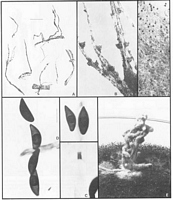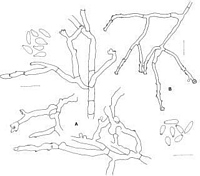|
 Xylaria sp. 1 Xylaria sp. 1
BiostatusPresent in region - Indigenous
Images (click to enlarge)
Caption: Fig. 17 Xylaria taxonomic species 1 A, Stromata (PDD 45344). B, Stromal surface (PDD
45344). C, Ascal ring (PDD 45344; Melzer's reagent). D, Ascospores (PDD 45344,
Melzer's reagent). E, Conidial stroma formed on OA (PDD 45345). F, Sclerotia for | 
Caption: Fig. 22 Xylaria anamorphs A, X. cf. myosurus (PDD 41977 from culture). B, X.
taxonomic species 1 (PDD 45345 from culture). |
Article: Rogers, J.D.; Samuels, G.J. (1987) [1986]. Ascomycetes of New Zealand 8. Xylaria. New Zealand Journal of Botany 24(4): 615-650 (http://www.rsnz.org/publish/abstracts.php).
Description: Stromata solitary, simple, bifurcate or several times branched below the apex and then
palmate, 2-7 cm long, filiform with whip-like tip; at first conidiogenous. Surface
olivaceous brown and fleshy when fresh, wrinkled, glabrous; perithecia nearly superficial,
intercalary, scattered, diagonally inserted, pyriform, 600 µm high x 400 µm; apex acute.
Asci 170-200 µm total length x 7-8 µm, sporiferous part (105-)110-150 µm, cylindrical;
apical ring J +, cylindrical, 2.5-3.0 µm wide x 4 µm high; 8-spored, ascospores uniseriate
with overlapping ends or partially biseriate. Ascospores (14.5-)16.0-20.0(-22.0) x (6.5-)7.08.:5(-9.0) µm,
naviculate with one end narrowed and the other end broadly rounded, or
fusoid; inequilateral with one side flat and the other side rounded, dark brown, transparent
to nearly opaque; slit nearly full length, 12-15 µm long, straight, parallel to long axis of the
ascospore. Conidiophores in vivo loosely disposed along the length of whip-like tips of
conidiogenous stromata. Conidia forming on swollen nodes of conidiogenous cells;
coriidiophores and conidia otherwise as found in culture.
CHARACTERISTICS IN CULTURE: Colonies grown 1 month at 20°C in diffuse
daylight on CMD 2 cm diam., felty, 'white but with abundant black sclerotia forming in the
aerial mycelium. Colonies on OA > 9 cm diam., otherwise as on CMD but colony
appearing black from abundant sclerotic. Sclerotic globose, 50-100 µm diam., solid,
pseudoparenchyrnatous, black, sterile. Conidia forming on CMD and OA but more
abundant on OA. Conidiophores on OA arising in aerial mycelium along lines of contact
between single ascospore isolates; also forming on scattered synnematous structures.
Synnemata forming only on OA, 1.0-1.5 cm long, white, branched, composed of 3-4 µm
wide hyphae. Conidiophores loosely dispersed along the length of the synnemata and
terminating hyphae of synnemal surface, irregularly branched, each branch terminating in a
15-40 µm long conidiogenous rachis; conidia forming along the length of the
conidiogenous rachis, conidiogenous scars c. 1 µm wide, with a refractive frill. Conidia
(4.0-)4.5-5.5(-6.0) x 2.0-3.0(-3.5) µm, clavate, colourless, smooth; each with a refractive, 1
µm wide, basal frill.
Habitat: HABITAT: On ground under living trees and on well rotted wood.
Distribution: DISTRIBUTION: NORTH ISLAND: Northland, Coromandel.
Notes: This fungus appears to be a distinct species related to X. cf. filiformis, X.
schwackei Henn., and X. vagans Petch (if indeed these names represent distinct species).
Xylaria cf. filiformis is usually considered to be an inhabitant of leaves, petioles and
herbaceous stems, whereas the two related species have been reported on woody substrates.
There are many described species of small wood-inhabiting Xylaria, however, and these
should be studied before concluding that the fungus under consideration is an undescribed
species. Xylaria taxonomic species 1 seems unusual in the loose (non-palisade)
arrangement of conidiophores on conidiogenous stromata.
|